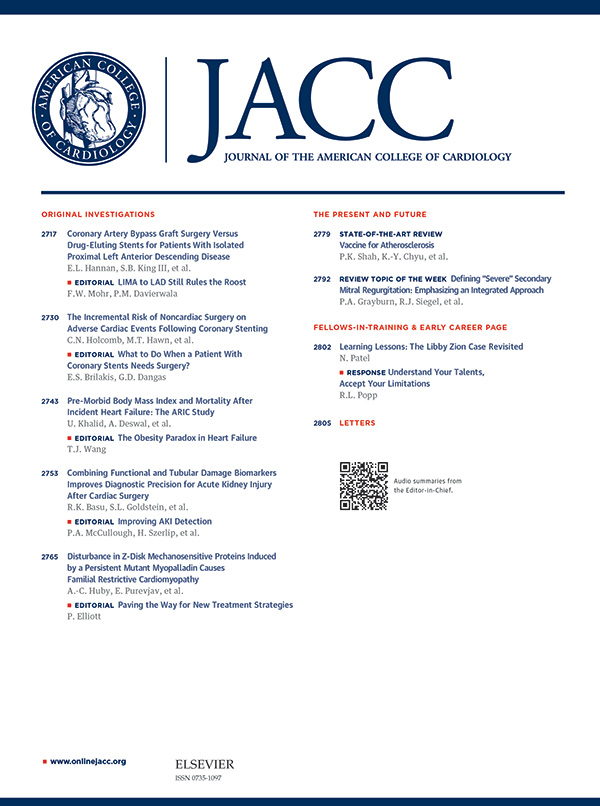Interplay of Chronic Kidney Disease and the Effects of Tirzepatide in Patients With Heart Failure, Preserved Ejection Fraction, and Obesity: The SUMMIT Trial
IF 21.7
1区 医学
Q1 CARDIAC & CARDIOVASCULAR SYSTEMS
引用次数: 0
Abstract
Background
Obesity leads to both heart failure with a preserved ejection fraction (HFpEF) and to chronic kidney disease (CKD); CKD may both influence the clinical course of obesity-related HFpEF; and incretin-based drugs may influence renal function.Objectives
This analysis had dual objectives: 1) to evaluate the influence of CKD on the clinical responses to tirzepatide in patients with obesity-related HFpEF; and 2) to investigate the complexity of tirzepatide-related changes in renal function. For both objectives, we focused on discrepancies between creatinine-based and cystatin C–based estimates of the estimated glomerular filtration rate (eGFR).Methods
The SUMMIT trial randomly assigned 731 patients with HFpEF and a body mass index ≥30 kg/m2, who were enriched for participants with CKD. Patients received either placebo or tirzepatide for a median of 104 weeks and were followed for cardiovascular death or worsening heart failure events and for changes in the Kansas City Cardiomyopathy Questionnaire Clinical Summary Score (KCCQ-CSS) after 52 weeks. Because of the confounding produced by obesity and changes in muscle mass, eGFR was assessed at randomization and after 12, 24, and 52 weeks by both creatinine-based and cystatin C–based formulae.Results
Patients with CKD (based on creatinine or cystatin C) had greater severity of heart failure, as reflected by: 1) worse functional class, KCCQ-CSS scores, and 6-minute walk distance; 2) higher levels of NT-proBNP and cardiac troponin T; and 3) a 2-fold increase in the risk of worsening heart failure events. CKD did not influence the effect of tirzepatide to reduce the relative risk of major adverse heart failure events and to improve KCCQ-CSS, quality of life, and functional capacity, but the absolute risk reduction in the primary events was numerically greater in patients with CKD. Regarding renal function assessments, baseline eGFR-cystatin C was consistently ≈9 mL/min/1.73 m2 lower than that eGFR-creatinine, with significant individual variance. Furthermore, tirzepatide increased eGFR at 52 weeks, assessed by both creatinine-based and cystatin C–based formulae, but with considerable discordance in individual patients. Tirzepatide produced a decline in eGFR at 12 weeks with eGFR-creatinine (but not eGFR-cystatin C), and it led to an improvement in eGFR at 52 weeks in all patients (when assessed by cystatin C), but only in patients with CKD (when assessed by eGFR-creatinine).Conclusions
The triad of obesity, HFpEF, and CKD identifies patients with considerable functional impairment and an unfavorable prognosis, who nevertheless respond favorably to tirzepatide. Long-term tirzepatide improves renal function (both by cystatin C and creatinine), but the measurement of eGFR in patients with obesity receiving incretin-based drugs is likely to be skewed by the effects of fat and muscle mass (and by changes in body composition) on the synthesis of both cystatin C and creatinine. (A Study of Tirzepatide [LY3298176] in Participants With Heart Failure With Preserved Ejection Fraction [HFpEF] and Obesity: The SUMMIT Trial; NCT04847557)

求助全文
约1分钟内获得全文
求助全文
来源期刊
CiteScore
42.70
自引率
3.30%
发文量
5097
审稿时长
2-4 weeks
期刊介绍:
The Journal of the American College of Cardiology (JACC) publishes peer-reviewed articles highlighting all aspects of cardiovascular disease, including original clinical studies, experimental investigations with clear clinical relevance, state-of-the-art papers and viewpoints.
Content Profile:
-Original Investigations
-JACC State-of-the-Art Reviews
-JACC Review Topics of the Week
-Guidelines & Clinical Documents
-JACC Guideline Comparisons
-JACC Scientific Expert Panels
-Cardiovascular Medicine & Society
-Editorial Comments (accompanying every Original Investigation)
-Research Letters
-Fellows-in-Training/Early Career Professional Pages
-Editor’s Pages from the Editor-in-Chief or other invited thought leaders

 求助内容:
求助内容: 应助结果提醒方式:
应助结果提醒方式:


